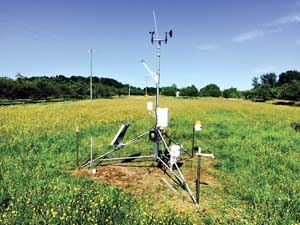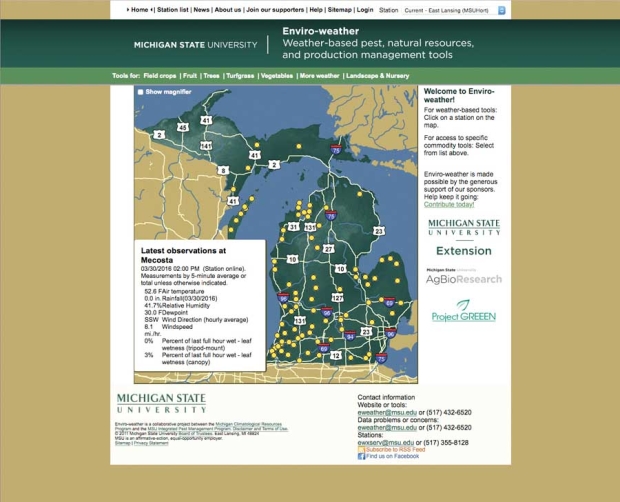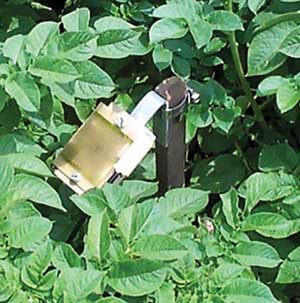
Each Enviro-weather station has a standard set of 12 sensors to make a variety of measurements, including maximum, minimum and current air temperature; soil temperature at 2-inch depth, total precipitation, relative humidity, wind, solar intensity and leaf wetness. (Courtesy of Enviro-weather)
For growers across Michigan and parts of Wisconsin, Enviro-weather continues to be the go-to website for following degree-days, predicting frost occurrences, finding rainfall totals, tracking pests, and planning the timing of insecticide and fungicide applications.
Part of what makes Enviro-weather so useful is that it is constantly expanding to provide new services that help growers make sense of the environmental conditions and how they ultimately affect their crops.
In addition to an increasing number of weather stations — now topping 80 — Enviro-weather implemented two new peach-harvest tools in 2015 and hopes to soon expand similar tools for apples.
Researchers are also currently reviewing the possibility of enhancing its weather data so that it can provide weather predictions in areas away from existing weather stations, down to within 2.5 kilometers (1.55 miles) of any location in the state.
Peach and apple tools
One of the new peach harvest tools predicts harvest dates for representative early-, mid- and late-season peaches (Garnet Beauty, Redhaven and Loring, respectively) in different regions throughout the state, while the second tool expands those predictions to include the majority of peach varieties — 76 of them — grown in Michigan and Wisconsin’s Door Peninsula.
“The question that always comes up is, ‘When is peach harvest going to occur?’” said Bill Shane, senior extension tree fruit specialist at the Southwest Michigan Research and Extension Center in Berrien County.
That led him a few years ago to develop a predictive model for Redhaven harvest to be used in that part of the state.
For that model, he used a regression analysis to determine the relationship between degree-days and the onset of Redhaven harvest that tapped data collected from the Southwest Michigan Center’s orchard since 1995.
The model worked well, so he decided to extend it to other regions and to other peach varieties.
“Being able to predict harvest timing is pretty important given that the start of the harvest for a particular variety can range over about two weeks from year to year: Chain stores want to know when to anticipate the loads are coming in so their marketing people can plan their advertisements; out-of-state visitors want to know when the major part of the season might be so they can plan their trips; and growers have to anticipate when they will need the labor to harvest and also have to be able to communicate with their buyers when they are apt to have that crop.”
Shane combined his model for Redhaven with knowledge of other varieties’ harvest dates relative to Redhaven to generate the new peach tools, which Enviro-weather added late last spring.
“For Enviro-weather, the idea was to automate the model, and to expand it so it would function for other locations in Michigan beyond the couple of sites where I work, and for all of these other varieties beyond Redhaven,” he said. “The prediction is better for older varieties, but will improve for newer varieties as we collect more data.”
Growers can use either peach tool by going to the Enviro-weather website (www.enviroweather.msu.edu), clicking on “Fruit” in the menu bar, opening the Peach folder and clicking on the tool of choice. There, options are available for selecting the region of the state and the closest station to the orchard.

Enviro-weather website at www.enviroweather.msu.edu. (Courtesy MSU)
“These tools really give you a feel for the variation of time of harvest in the area,” said Beth Bishop, coordinator of Enviro-weather.
She noted that Enviro-weather is a team effort that includes co-directors state climatologist Dr. Jeffrey Andresen, MSU professor of geography, and Dr. Larry Olsen, who is a professor in the MSU Department of Entomology, as well as “a small group of very dedicated and hard-working individuals.”
In a similar project, Bishop hopes to increase the scope of Enviro-weather’s apple-maturity tool in either 2016 or 2017, taking it from its current prediction of harvest dates for three varieties to one that forecasts maturity for many more.
“For apples, we’ve been using a bit more complicated of a model over the years than the one we have for peaches,” Shane said, explaining that the apple model is actually an averaging of three heat models developed by different fruit experts. That model predicts the harvest dates for three varieties: McIntosh, Red Delicious and Jonathan.
Shane and Phil Schwallier, MSU district horticulture agent and director of the Clarksville Horticulture Experiment Station, are hoping to upgrade the model to include 10 to 15 of the most common apple varieties grown in Michigan.
“Again, we want to make it easy for growers to get that prediction for their own particular area and variety,” Shane said.
Filling in weather gaps
Harvest-date estimates aren’t the only things that depend on comprehensive weather data. Everything from the need for supplemental irrigation and frost-protection measures to the timing of pesticide and fungicide applications relies on accurate and complete weather information for the grower’s location.
Enviro-weather’s network of weather stations do a wonderful job of gathering and automatically sending streams of key measurements to the centralized server and database, but gaps still exist, Bishop said.
For instance, growers may not feel the nearest station gives a good approximation of the conditions at their particular orchards.
This could result from the surrounding topography or the sheer distance to the nearest Enviro-weather station, particularly in northern and inland parts of the state where stations are sparse.
“Of course a solution would be to put a station on every farm, but that’s not feasible with stations that cost $7,000 just for the parts,” she said.
Even for orchards well served by existing stations, however, sensors may fail or batteries may die. Although they are quickly repaired, some data from that station is occasionally lost and that could affect summary data, such as degree-day accumulations.
The next best thing is to find a supplemental source of weather data that blankets the state more completely and can fill in any data holes. So-called “gridded data” from the National Weather Service may be the answer.
Gridded data is meteorological information from sophisticated computer models that are adjusted based on data from a variety of observational datasets, including weather-station and satellite observations, and then provided for every point on an equally spaced grid.
“Gridded data would help to not only temporally fill in a gap if one of our weather stations is malfunctioning, but also to spatially fill in a gap between stations,” said Dr. Michael Kiefer, assistant professor in the MSU Department of Geography who works on projects through MSU’s Climatologist’s Office.
He is analyzing the potential of Real-Time Mesoscale Analysis (RTMA) gridded data for use with Enviro-weather. RTMA data provides detailed weather information at 2.5 km intervals.
Such small intervals will be especially helpful in the Great Lakes region, where large weather fluctuations can occur over small areas.
Besides helping growers understand the weather at their specific orchards, the gridded data may help instruct Enviro-weather administrators about where they should consider a denser network of stations to provide a better picture of weather variability, Kiefer said.
Kiefer and his research group have been studying gridded data and its potential applications for Enviro-weather by comparing gridded data points with actual weather-station observations at 12 sites and over five years.
They have found, for example, that the gridded data slightly underestimates daily maximum temperatures and overestimates minimums, but overall, they believe the gridded data is acceptable for use with Enviro-weather.
Bishop is similarly optimistic. “We’re working toward incorporating gridded data to fill in the gaps this year,” she said. “We’re really excited about it, because we think it will be a huge asset.”
All in all, Enviro-weather is an online set of tools that can be a real boon to growers, Bishop said. “We have information about cherries, apples, peaches, pears, grapes, blueberries and other small fruit, plus all kinds of other crops. We have tools for harvest times, as well as for pests and diseases, which keep expanding. In fact, we’re adding a tool for cherry fruit worm this year.”
Just like the weather seems to change every five minutes in Michigan, Enviro-weather continues to transform to meet the needs of growers. Said Bishop, “We definitely have a lot of other ideas and things in the works.” •
More than the weather

The leaf-wetness sensor acts as a simulated leaf and measures dew. (Courtesy of Enviro-weather)
Enviro-weather does far more than provide the daily environmental conditions for Michigan growers. It tracks weather data and turns it into actionable information by layering on a collection of analytical tools and predictive computer models that can help make an operation more efficient and more productive.
Enviro-weather coordinator Beth Bishop provided a sampling of the resources available to fruit growers:
Reports on weather conditions. Growers can access weather reports for any of Enviro-weather’s 81 weather stations (including two new ones added in 2015) for any time range.
“One of our most frequently used applications gives you a daily temperature maximum and average for the dates you select; degree-day accumulations using the degree-day base you want; the rainfall for each day; and the total accumulation of rainfall since the beginning of the year,” she said. “A lot of people use this application because they can really drill down to see the conditions for each of the days in that time range.”
Insect models that calculate insect development. Based primarily on temperature, these models can help growers schedule pesticide applications to the best advantage.
“Many of these insect models rely on the ‘biofix,’ which is the date of some observable occurrence that starts a countdown clock,” Bishop explained. “For instance, the biofix for codling moth is the first sustained catch of adults in the pheromone traps that the growers put out. Once the grower gets that, the countdown clock for accumulating heat begins and that will ultimately predict when eggs are laid and when control is needed.”
On Enviro-weather, the grower can go to a chart in the codling moth application, locate his or her biofix date, and follow it down to find the date range that coincides with optimal pesticide application. Other insect-pest models include those for oblique-banded leaf roller, oriental fruit moth, plum curculio, apple maggot and grape berry moth. A model for cherry fruit worm is coming in 2016.
Disease models that anticipate outbreaks. “Disease models are more complex than those for insects, because they have to take into account temperature as well as moisture,” Bishop said.
She noted that each weather station has a sensor to measure how long leaves remain dry or wet. Many diseases only progress under wet conditions when temperatures are warm, but prolonged periods of dryness can stop development in its tracks.
“That’s all taken into account in these models,” she said. Some of the disease models include apple scab, fire blight, sooty blotch, flyspeck, cherry leaf spot and black rot of grapes.
In addition to these applications and models, Enviro-weather provides links to MSU Integrated Pest Management and other extension resources that deal with diseases, pests, and a wide range of topics including coping with freeze and drought conditions and fruit management strategies.
– by Leslie Mertz, Ph.D., a freelance writer based in Gaylord, Michigan.






Leave A Comment